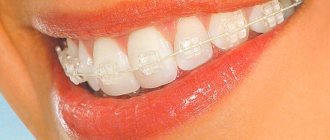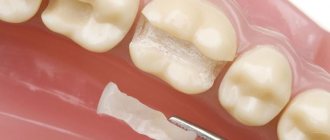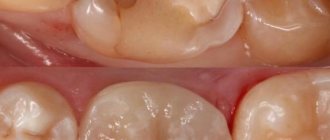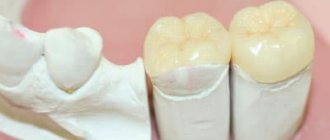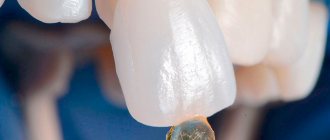home
Aesthetic dentistry
Dental restoration
Don't despair if your teeth become chipped, cracked, or if part of a tooth breaks off completely. The specialists of the PROFI-Dent clinic can easily and quickly cope with any dental problems.
Modern dental restoration allows not only to qualitatively eliminate the existing dental defect, but also to correct the shape, position and appearance, making the dentition impeccably straight and the smile luxurious.
Your teeth require aesthetic restoration if you have the following problems:
- carious lesions of tooth tissues;
- cracks, chips of tooth enamel;
- presence of a tooth of irregular shape, size or color;
- enamel defects resulting from trauma;
- darkening and pigmentation of the enamel that cannot be eliminated by whitening (tetracycline teeth, fluorosis);
- chips, gaps between teeth;
- old dark fillings;
- wedge-shaped defect, enamel erosion;
- loss of more than 30-50% of tooth tissue, which cannot be compensated by simple filling.
Dental restoration of teeth allows using different materials to recreate lost or damaged tissue, eliminate enamel defects and maintain a brilliant smile at any age. We offer the most affordable prices for dental restoration in Moscow.
Material shrinkage is one of the reasons for replacing old fillings
Protection of the tooth from infection is ensured by the tightness of the connection at the border of the filling with the tooth tissue. Modern adhesive compounds reliably glue the filling to the tooth, but sometimes this can become a problem.
During curing, any material decreases in volume ( shrinks ) and filling material is no exception. By shrinking, the filling “pulls” on itself the parts of the tooth to which it is securely glued, and if the area of the filling is large, this force may be enough to cause cracks and chips to appear.
secondary caries forms at the site where the filling is torn from the tooth tissue .
Shrinkage of the filling material also poses other problems:
- with vertical shrinkage, the height of the bite changes, which leads to dysfunction of the temporomandibular joint and improper load on the filled tooth. As a result, the tooth may become damaged and require a crown to be installed to restore it.
- shrinkage of the filling horizontally leads to the disappearance of the contact point (point of contact) between adjacent teeth and stuck food puts pressure on the periodontal papilla, injuring it. The gums become inflamed, gingivitis, periodontitis and secondary caries develop.
How does the installation work?
- Using a drill, the tooth is slightly ground down for better adhesion of the filling to the tooth.
- Thorough treatment with antiseptic drugs.
- Applying a special filling substance to the tooth, evenly distributing the composition.
- Polymerization using a blue lamp.
- At the end of the procedure, sanding and polishing are carried out to make the unit as similar as possible to the rest.
On average, installing a light seal will cost 4-7 thousand. Some clinics often hold promotions, thanks to which you can restore a tooth at a reduced price.
What are the consequences of insufficient filling strength?
The technology for making a filling (in the patient’s mouth) does not make it as strong as possible, so over time the filling material wears out.
As in the case of vertical shrinkage, abrasion of the filling can lead to problems:
- the level of bite changes , and this can lead to the chipping of part of the tooth due to the redistribution of the chewing load from the filling to the walls of the tooth.
- the boundary between the filling and the tooth tissue changes , while the filling loses its tightness and the infection penetrating inside provokes the development of secondary caries.
Removing a filling from a tooth: the removal process
Depending on the material from which the seal was made, the methods for removing it also differ.
- Cements and composite materials. Fillings made from silicophosphate or zinc phosphate dental cements, ceramic or polymer composites are among the strongest. These types of fillings are removed by drilling with a drill with small nozzles.
- Pastes for filling. Such fillings are removed using special solvents or a burr with extended attachments.
- Amalgam. An amalgam (metal alloy) filling is removed using a cross-shaped cut, after which the particles are cleared from the tooth cavity using a metal cutter.
Removal of the old filling is completed by thoroughly cleaning the tooth cavity from carious tissues and installing a new filling.
Other disadvantages of the filling and reasons for replacing it
- Inaccurate anatomical shape of the tooth.
Restoring the correct shape of a tooth in a patient’s mouth is a difficult task. This work requires the dental therapist to have a good knowledge of anatomy and the skill of a sculptor. But even with these skills, it is difficult to model the shape of a tooth in hard-to-reach places.Inaccurate tooth shape is the cause of malocclusion (especially if there are a lot of fillings). Teeth grind food incorrectly, causing discomfort when biting, headaches appear, teeth are injured in the process of chewing food and are destroyed over time.
- Overhanging edges of the filling.
If, when installing a filling, the material flows onto the gum and rests on it, this leads to permanent injury and inflammation of the gums.A filling installed with such a defect causes local periodontitis and secondary caries, since it is difficult to remove stuck food from the resulting “pocket.”
- Difficulty in thoroughly sanding surfaces .
In places of contact with neighboring teeth, it is impossible to completely get rid of the roughness of the filling, and dental plaque adheres well to such a surface. - Development of caries at the interface between tooth and filling . The gradual shrinkage of the filling material and the destruction of the adhesive connection makes the border between the tooth and the filling the most vulnerable place where secondary caries develops first.
- Changes in the color of the filling material and tooth tissue over time make the border of the filling too noticeable.
What to do when a filling falls out
Further treatment tactics depend on the patient’s behavior after the temporary filling falls out. If you do not take any action and wait for your appointment, then most likely the doctor will have to re-clean the tooth cavity or even carry out additional procedures to eliminate pathological processes that have arisen due to external factors. An open tooth is accessible to all infections and is highly undesirable at any stage of treatment.
If the filling falls out on the day of installation
In cases where the temporary filling falls out after 2 hours or approximately this time, you must immediately contact a specialist for re-filling.
What should you do if a temporary filling falls out in the evening, when you can no longer visit the dentist? In such a situation, it is necessary to close the cavity. For this, for example, you can purchase a special dentin paste or its analogues at the pharmacy. You should try to remove the remains of the filling, but without using sharp objects, so as not to damage the internal tissues and channels. After this, the cavity is filled with paste, and the next day they are sent to the attending physician.
If it is not possible to purchase such a paste, it is recommended to minimize food intake and constantly rinse your mouth with mouthwash or other antiseptic agents. Rinsing is necessary after each meal to flush out food particles from the exposed tooth that may get into the cavity.
Loss of filling in sealed and unsealed canals
The greatest risk occurs when a temporary filling falls out and the canals are not sealed. Due to the high probability of contamination of the dental canals, the patient should also “seal” the tooth with paste, or rinse the tooth regularly. You can also use a soda solution for rinsing. On the same day or the next day, the patient must go to the clinic to take measures to close the cavity in the crown.
If a temporary filling falls out, but the canals are sealed, what should I do? In such patients, the likelihood of complications is minimal, since neither infection nor foreign particles can penetrate into the canals themselves. But it is still impossible to leave the cavity open, since the crown is weakened and its internal tissues are not protected from mechanical stress. Patients are also advised to rinse as a preventative measure and to see a dentist again, who may even install a permanent filling right away.
What does replacing a filling lead to?
What's wrong with changing the filling when needed? The problem is that you don’t know the exact time when the old filling stops performing its functions, but if part of the tooth breaks off, the doctor will be forced to put in a new, larger filling.
In the case of advanced caries and pulpitis, it may be necessary to remove the nerve, but a “dead” tooth is more fragile and fillings and inlays adhere less well to its tissues (which means the service life will be shorter).
We devoted the article Karis to the treatment of different stages of caries: what is it like? And why does treatment differ so much in price? Read it to understand how caries progresses.
With each filling replacement, the “native” tooth becomes smaller and the moment approaches when it can only be restored with a crown.
A child's filling fell out
And of course, we cannot fail to mention the loss of fillings in children. Caries and its treatment in baby teeth are often complicated by several reasons, including the child’s young age, or fear of the dentist.
Caries on baby teeth develops quite rapidly. That is why hygiene of baby teeth in children should be a high priority. If you really monitor the health of your child’s teeth and follow all the necessary hygiene and preventive measures, then treatment and installation of a filling will not take more than 30-40 minutes.
You can often hear stories about how a doctor cured two teeth for a child in 15 minutes. It should be understood that dental treatment is a rather complex process and requires some time, and each stage must be performed carefully and professionally. Fast work in this case cannot be an indicator of quality and skill. Take care of the health of your children, do not allow yourself to be misled. You have the right to demand from the doctor conscientiousness and honest performance of his work!
Why is a ceramic inlay better than a regular filling?
Unlike a filling, which a doctor makes in the mouth, an inlay goes through all stages of manufacturing in a dental laboratory. The dentist only processes the tooth cavity under the inlay and makes impressions of the jaws, and after making the inlay, glues it in place.
Restoring a tooth with an inlay requires two visits to the dentist, but ensures long-term functionality and aesthetic perfection of the restoration.
Advantages of ceramic inlays:
- Inlays do not shrink after placement because this process is completed during the manufacturing stage in the dental laboratory.
- Ceramic inlays have the highest strength and do not wear out over time, thanks to production technology. The inlay is pressed from a ceramic mass heated to high temperatures or machined from a single piece of ceramic.
- Inlays completely restore the anatomical shape of the tooth and chewing functions, thanks to the modeling of the bite in the articulator using casts of two jaws.
- Making an inlay with fitting on a plaster model makes it possible to create it without overhanging edges , restore tooth defects in hard-to-reach places, ensure correct interdental contact and good marginal fit of the inlay to the tooth. All this is difficult to do when making a filling in the oral cavity.
- All outer surfaces of the inlay (including those in contact with adjacent teeth) are perfectly ground before installation.
- It is easier to select the desired color and translucency of the inlay in the laboratory than in the patient’s mouth. Therefore, ceramic inlays are the best option for aesthetic dental restoration.
- The inlay is more reliably glued to the tooth, since the doctor requires a minimum of time to install an inlay of exactly the right size into the treated tooth cavity (due to the speed of installation, the risk of moisture and infection on the treated surfaces is reduced).
By restoring a tooth with a ceramic inlay, you get a high-quality, durable restoration and do not get tired during the appointment, since you do not need to sit for a long time with your mouth open.
For medical reasons, if the coronal part of the tooth is destroyed by more than 30%, it is recommended to install an inlay.
How much does tooth restoration cost in Moscow?
By contacting PROFI Dent dentistry, you will be convinced that inexpensive dental restoration in Moscow is by no means a myth, but a real opportunity to make your smile beautiful.
The cost is influenced by many factors - the complexity of the case, the amount of work, the technology used, the price of the material, the need for additional procedures, etc.
The doctor will announce the final price during the consultation, after the examination, and you can familiarize yourself with the price list now.
| Price list for prosthetics at the PROFI-Dent clinic | |
| Restoration of wedge-shaped defect, enamel erosion | from 3,000 rubles |
| Restoration of the frontal group | from 5,000 rubles |
| Filling made of light-curing material | from 2,200 rubles |
| Artistic restoration made from light-curing material | from 5,000 rubles |
| Ceramic-composite veneer | from 8,000 rubles |
| Installation of dental jewelry | 1,000 rubles |
Types of ceramic inlays
- inlay tab - restores the “cavities” of the tooth crown
- onlay tab - restores most of the chewing surface of the tooth crown
- overlay tab - restores the chewing surface and side walls of the tooth crown
The service life of the inlays is more than 10 years, while the filling will require replacement after an average of 5 years.
Now, when a dentist suggests restoring a tooth with an inlay, you know what benefits this will provide in the future.
Which one is better to choose for the smile area?
If you are thinking about which option to choose for dental restoration, the best option in terms of price and quality is a light filling. It has a number of positive aspects:
- There is no need to wait two hours to eat and drink after a dental procedure.
- It is characterized by high strength and a longer service life. On average, a light filling lasts up to 7 years.
- Absolute safety for the body.
- It is possible to choose the color of the seal so that the restored unit does not differ from the rest.
Methods of tooth restoration
The choice of restoration method is influenced by how much the tooth is damaged. It could be:
- Composite filling. Used for minor damage.
A composite or veneer is used to eliminate defects in teeth located in the smile area.
A veneer is a very thin plate of porcelain that is made by a dental technician based on an individual impression in a laboratory.
Componier is a cheaper analogue of veneer, made from a composite at the factory.
- Ceramic or composite inlay. Used for severe tooth decay. The inlay is the same filling, only larger in size, which is made in the laboratory. It has the best strength characteristics, repeats the anatomy of the tooth surface and matches it in shade.
- Metal-ceramic or zirconium crown. A crown is used to restore significantly damaged teeth, avoiding extraction and preserving the dental unit.
Filling of anterior teeth
In the case of front teeth, the aesthetic aspect comes to the fore, so the filling material must have the appropriate properties. Although the front teeth receive better hygiene due to their accessibility, they are also susceptible to caries. Installing a filling on the front teeth is considered a more complex procedure: it is necessary not only to give the filling the desired shape, but also to choose the right color. In most cases, filling of anterior teeth is carried out using compomers, as well as light composite fillings, which harden under the influence of ultraviolet radiation. Be that as it may, in case of serious damage, it is impossible to achieve good aesthetics with the help of filling, so you often have to turn to orthopedic solutions.
Types of dental fillings
Classic filling of carious teeth involves the installation of a dental filling without depulpation of the root canals. This technique is used for minor mechanical and carious damage to the tooth (superficial and medium caries) and is carried out in several stages.
When the dental pulp is damaged, in most cases it is necessary to fill the root canals of the teeth. In the case of milk and young molars, there are methods for preserving the functionality of the root - a biological method of treatment using calcium-containing preparations (tooth filling with calcium) or partial amputation of the pulp. This allows you to maintain the blood supply to the tooth and its vitality, which is especially important when it is in the development stage.
Depulpation involves removing the tooth root, cleaning and developing the canals with special instruments and filling them with artificial materials in order to eliminate the risk of developing inflammatory processes. There are various methods of root canal treatment. There is no absolutely ideal method, so the doctor focuses on a specific clinical case.
Installing a seal on a pin
More recently, it has become common practice in dentistry to install a filling on a post if the tooth is more than 50% destroyed. Thus, the technique made it possible to avoid prosthetics. Filling a tooth with a pin must be preceded by removal of the nerve. Then a special screw is inserted into the root canal and fixed with cement. The procedure is completed by layer-by-layer application of light-polymer composite materials. However, installing a pin does not guarantee reliability and safety. Over time, the cement breaks down, causing microbes to get under the filling, causing the formation of caries. Having chosen modern dentistry to install a filling, you are unlikely to encounter such technology.


